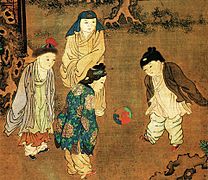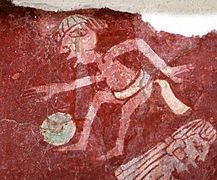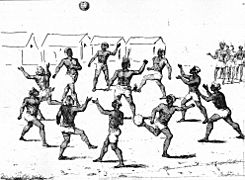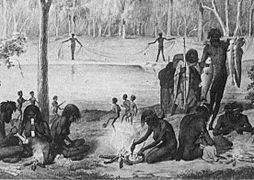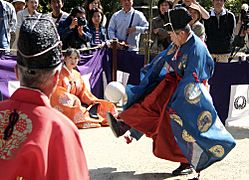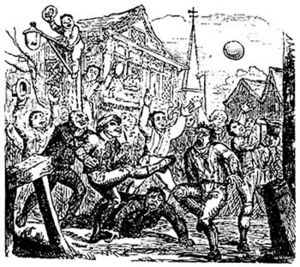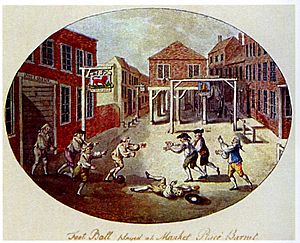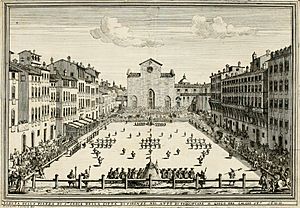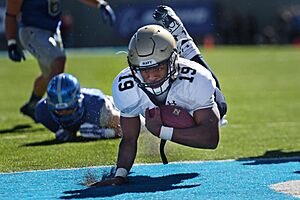Football facts for kids
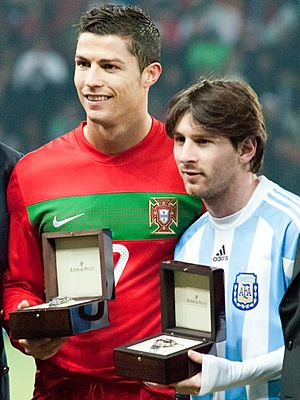
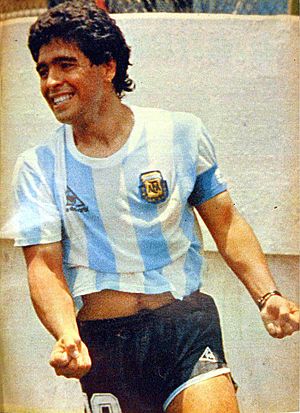
Football is a word that can mean several different sports. The most famous type of football is association football. This sport is often called "soccer" in places like North America, South Africa, and Australia. This helps avoid confusion with other popular football games played there.
The name football comes from the words 'foot' and 'ball'. It's called football because players mostly walk and run on their feet during the game. This is different from sports like polo, where players ride horses. Football is played with a ball, also called a 'football'. This ball is usually shaped like a sphere (a round ball) or an ellipsoid (an oval shape). Players often kick the ball with their foot. However, in some types of football, they can also use other parts of their body or even their hands.
People have played games similar to football for a very long time. Some of the earliest records come from China in the second and third centuries AD. The modern versions of rugby football and association football started in 19th-century England. Kicking a ball has been a part of games since the Middle Ages. Association football became popular across Europe and then spread worldwide through colonization. Today, it's the most popular sport globally. Many people watch it on television, especially the FIFA World Cup, which happens every four years.
Every year, there's a big club competition called the Champions League. All the best teams that qualify get to play. At the end, one team wins the famous UEFA trophy. Many top players like Mbappe, Ronaldo, Messi, Dybala, and Neymar play in this tournament every year.
The History of Football
Ancient Ball Games
Football in Ancient China
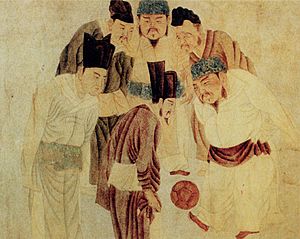
The Chinese game cuju (蹴鞠) was a competitive game similar to modern association football. Descriptions of it can be found in a military book from the second and third centuries BC. It was played during the Han dynasty and possibly even earlier. A Japanese version of cuju is kemari (蹴鞠). This game developed during the Asuka period and was played in the Japanese imperial court in Kyoto around 600 AD. In kemari, several people stand in a circle and kick a ball to each other. They try to keep the ball from touching the ground, much like "keepie uppie."
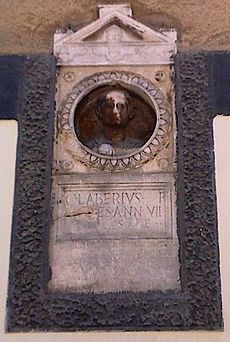
Football in Ancient Greece and Rome
The Ancient Greeks and Romans played many ball games, and some of these involved using their feet. The Roman game harpastum is thought to have come from a Greek team game called "ἐπίσκυρος" (Episkyros). A Greek writer named Antiphanes mentioned this game. These games were probably similar to rugby football. A Roman politician named Cicero once wrote about a man who was killed while getting a shave because a ball was kicked into the barber's shop. Roman ball games even used air-filled balls. FIFA recognizes Episkyros as an early form of football.
Football Among Native Americans
Many traditional ball games were played by indigenous peoples around the world. For example, in 1586, an English explorer named John Davis saw Inuit people in Greenland playing a form of football. Later, there were stories of an Inuit game played on ice called Aqsaqtuk. Two teams would line up and try to kick the ball through the other team's line and into a goal. In 1610, a colonist named William Strachey saw Native Americans playing a game called Pahsaheman in Virginia. Another game, Pasuckuakohowog, similar to modern association football, was played by Amerindians as early as the 17th century.
Games played in Mesoamerica with rubber balls are also well-known. These games existed long ago, but they were more like basketball or volleyball. There's no clear link between them and modern football. Northeastern American Indians, especially the Iroquois Confederation, played a game using net racquets to throw and catch a small ball. This game, now called lacrosse, is not usually considered a form of "football."
Football in Oceania
On the Australian continent, several indigenous tribes played kicking and catching games with stuffed balls. Historians often call these games Marn Grook. The earliest story about this game comes from 1878. A man named Richard Thomas said that around 1841 in Victoria, Australia, he saw Aboriginal people playing. He described how players would kick a ball made from a possum skin, and others would jump high to catch it. Some historians think Marn Grook might have been one of the origins of Australian rules football.
The Māori in New Zealand played a game called Ki-o-rahi. In this game, two teams of seven players play on a circular field with different zones. They score points by touching boundary markers called 'pou' and hitting a central target called a 'tupu'.
These ancient games show that ball sports have been around for a very long time. However, most modern football games come from Western Europe, especially England.
Football Among Turkic Peoples
Mahmud al-Kashgari, a scholar, wrote about a game called "tepuk" played by Turks in Central Asia. In this game, people tried to attack each other's "castle" by kicking a ball made of sheep leather.
-
A Song dynasty painting showing Chinese children playing cuju
-
A painting of a Mesoamerican ballgame player from the Tepantitla murals in Teotihuacan
-
A group of indigenous people playing a ball game in French Guiana
-
An illustration from the 1850s of indigenous Australians playing marn grook
Medieval and Early Modern European Football
During the Middle Ages, annual Shrovetide football games became very popular across Europe, especially in England. An old mention of a ball game in Britain is from the 9th century, describing "a party of boys ... playing at ball." In northern France, a game called La Soule was played in the 12th century. Players used their hands, feet, and sticks to move the ball.
Early forms of football in England were sometimes called "mob football". These games were played in towns or between villages. There were no limits on the number of players, and opposing teams would clash in large groups. They tried to move an object, like an inflated animal's bladder, to specific points, such as their opponents' church. These games were often played during religious festivals like Shrovetide, Christmas, or Easter. Some Shrovetide games are still played today in certain English towns.
The first detailed description of football in England was given by William FitzStephen around 1174–1183. He wrote about what London youths did during the annual festival of Shrove Tuesday:
After lunch, all the young people of the city go out into the fields to play a ball game. Students from each school have their own ball, and workers from each city craft also bring their balls. Older citizens, fathers, and rich people come on horseback to watch the younger ones compete. They enjoy seeing the action and the fun the carefree teenagers are having.
Many early mentions of the game simply say "ball play" or "playing at ball." This suggests that the games didn't always involve kicking the ball.
An early reference to a ball game that was likely football comes from 1280 in Ulgham, England. It says, "Henry... while playing at ball.. ran against David." There's also a record of football being played in Ireland in 1308. Another mention from 1321 in Shouldham, England, says: "During the game at ball as he kicked the ball, a lay friend of his... ran against him and wounded himself."
In 1314, Nicholas de Farndone, the Lord Mayor of London, issued a rule banning football in London. He said there was "great noise in the city caused by hustling over large foot balls... from which many evils might arise." He ordered that such games should not be played in the city again. This is one of the earliest official bans on football.
In 1363, King Edward III of England banned "handball, football, or hockey; coursing and cock-fighting, or other such idle games." This shows that "football" was already seen as different from games using other body parts, like handball.
A game called "football" was played in Scotland as early as the 15th century. It was even banned by a law called the Football Act of 1424. This law was not officially removed until 1906. There is also evidence of schoolboys playing a "football" game in Aberdeen in 1633. Some people think this might be an early mention of passing the ball. The original Latin words suggest hitting the ball back and forth. It's not certain if the ball was passed between teammates. The word for "goal" meant a "pillar at each end of a Roman chariot race track." One sentence suggests that handling the ball was allowed.
King Henry IV of England used the English word "football" in 1409. He issued a rule stopping people from collecting money for "foteball."
There's also a Latin account from the late 15th century about football in Caunton, Nottinghamshire. This is the first description of a "kicking game" and the first mention of dribbling. It says young men "propel a huge ball not by throwing it into the air but by striking it and rolling it along the ground, and that not with their hands but with their feet... kicking in opposite directions." The writer also mentions a football pitch, saying: "The boundaries have been marked and the game had started."
Other important firsts from the medieval and early modern times:
- The word "a football" (meaning the ball itself) was first used in 1486.
- King Henry VIII of England ordered a pair of football boots in 1526.
- Women playing a form of football was first described in 1580 by Sir Philip Sidney in a poem.
- The first mentions of goals are from the late 16th and early 17th centuries. In 1584 and 1602, John Norden and Richard Carew talked about "goals" in Cornish hurling. Carew described how goals were made: "they pitch two bushes in the ground, some eight or ten foote asunder; and directly against them, ten or twelue [twelve] score off, other twayne in like distance, which they terme their Goales". He also first described goalkeepers and passing the ball between players.
- The first direct mention of scoring a goal is in John Day's play The Blind Beggar of Bethnal Green (around 1600).
Calcio Fiorentino
In the 16th century, the city of Florence, Italy, played a game called "calcio storico" ("historic kickball") in the Piazza Santa Croce. Young noblemen would dress in fancy silk clothes and play a very rough form of football. For example, calcio players could punch, shoulder charge, and kick opponents. Even blows below the belt were allowed. This game is thought to have started as military training. In 1580, Count Giovanni de' Bardi di Vernio wrote a book about the rules of Calcio Fiorentino. This is sometimes called the earliest rulebook for any football game. The game stopped being played after 1739, but it was brought back in May 1930.
Attempts to Ban Football
There have been many attempts to ban football games, from the Middle Ages until today. The first such law was passed in England in 1314. More than 30 bans followed in England alone between 1314 and 1667. Women were banned from playing at English and Scottish Football League grounds in 1921. This ban was only lifted in the 1970s. Female footballers still face similar challenges in some parts of the world.
American football also faced pressure to be banned. The game played in the 19th century was very rough, similar to the "mob football" of medieval Europe. Some cities banned it in the mid-19th century. By the 20th century, the game had become more like rugby. In 1905, people called for American football to be banned because it was too violent. A meeting hosted by American president Theodore Roosevelt that year led to big rule changes. These changes made the sport very different from its rugby roots, making it more like the game played today.
Different Types of Football
- Association football (soccer)
- American football
- Rugby league football
- Rugby union football
- Gridiron football (a general term for American and Canadian football)
- College football
- Touch rugby (called "touch football" in Australia)
- Canadian football
- Gaelic football
- Australian Rules Football
Images for kids
-
The Rugby School became famous because a story says rugby football was invented there in 1823. However, most sports historians say this story is not true.
-
A football match during Shrove Tuesday in Kingston upon Thames, England, 1846.
-
Tom Wills, often called the father of Australian football.
-
A wood engraving of an Australian rules football match in Melbourne, 1866.
-
The Tigers of Hamilton, Ontario, around 1906. This team later became the Hamilton Tiger-Cats, who still play in the Canadian Football League.
-
The All-Ireland Football Final in Croke Park, 2004.
-
An indoor soccer game in Mexico. The referee has just given the red team a free kick.
-
Women's beach soccer game at YBF 2010 in Yyteri Beach, Pori, Finland.
-
Griffins RFC Kotka, the rugby union team from Kotka, Finland, playing in a Rugby-7 Tournament in 2013.
-
Harrow football players after a game at Harrow School (around 2005).
See also
 In Spanish: Fútbol (homonimia) para niños
In Spanish: Fútbol (homonimia) para niños


